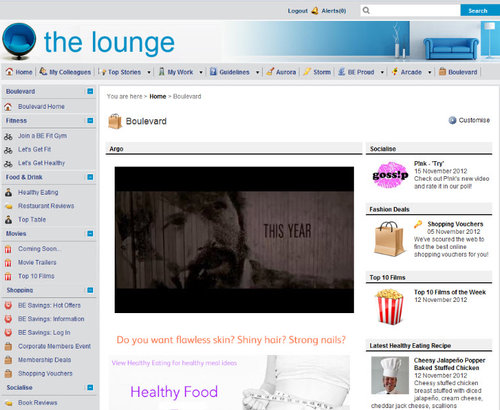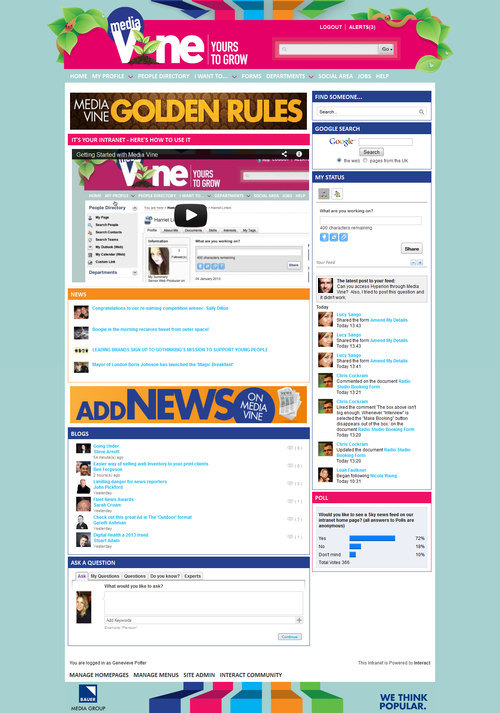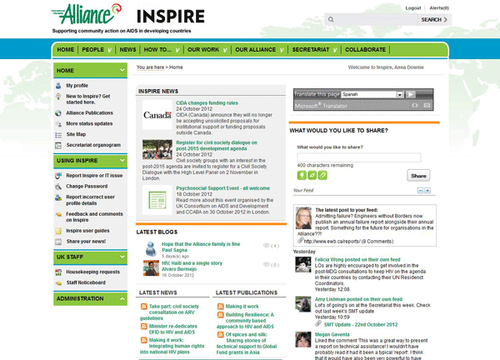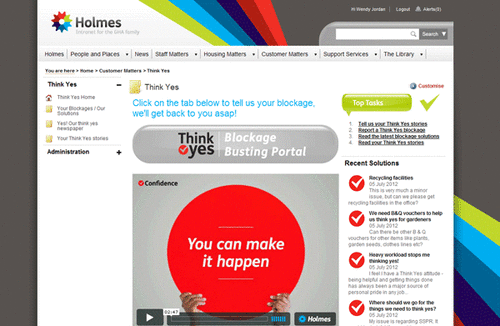Demystifying Social Intranets: part 2
Part 2: Good Social Practice is Not a Walled Garden
In my last blog we discussed the concepts behind social intranets and clarified the terms used in them. Now I want to look at practical examples of how social intranets work and what the benefits look like in real situations. Before we do here’s an example of what social is not.
Avoid Walled Gardens
Famously North Korea does not have internet access, it has a national intranet called Kwangmyong (translating as “Walled Garden”). Content from the outside world and within their borders is vetted, only a select few can upload content and commenting does not exist. This isn’t too far off the approach on a lot of traditional intranets – authors in splendid isolation. This model is the antithesis of a social intranet.
How Does a Social Intranet Work in Reality?
Your company is interviewing three people for a role. Often a senior manager will conduct a final interview but they have called in sick.
You have a lot of work for this role to do so don’t have the option of postponing but you need a competent interviewer. You could go to HR to see if they can think of anyone who can come in last minute, but what if they can’t?
Traditionally you’d send a mass email and hope someone reads it that can help, ask a few managers sat near you or post a key alert out on your intranet homepage for that office.
Using collaborative intranet features you could search for ‘interview’ or ‘recruit’ and reasonably expect somebody to come up in that search. They may not necessarily be part of your internal recruitment team (you might not even have one); they might
- have answered a question posted by an employee
- created content or a blog
- tagged their profile with interview or recruit
- added it as a skill or interest
- been @tagged by someone else when you’ve asked the question “Do we have an experienced interviewer available to help today?” on your intranet.
Once you identify this person you can either call them immediately or post your urgent request for help on their profile wall.
How Do I Get Social Started On My Intranet?
You can slowly introduce collaborative tools on your intranet or you might choose to make everything available at once. I recommend introducing features as the business need arises to avoid the horror of empty forums and tumbleweeds for status updates further down the line. However a lot of people will already have exposure and expectations from social technology due to their web 2.0 experiences, particularly digital natives, often traditional intranets feel dated because of this as McKinsey demonstrated:
We recommend finding advocates above and below. Look for members of the management to lead by example and also make the most of your contacts on the front line and get some of them to become early adopters too, ideally people of different ages and different departments. This will reinforce the idea social is for everyone and can be done by anyone.
Social Intranet Success Stories
Joni Vass of Business Environment, winners of Interact’s 2012 Social Idol award, a provider of hosted office spaces, has included game competitions, movie reviews and social teams in their intranet to encourage people to use the intranet and be comfortable with sharing knowledge. This has resulted in a phenomenal 100% user adoption and a balance of 86% business conversation against 14% social conversation, going social doesn’t mean creating an avenue for people to waste time.
One of Business Environment’s users told us:
“Our intranet has changed the way we work! It’s an awesome place to visit (even on a weekend) for everything from entertainment to company procedures. We are kept up to date with the latest gossip and feel part of a much bigger team. It’s often a talking point in the office. Games, quizzes and other opportunities are on the Intranet to win points, which are later cashed in for vouchers.
It’s a great tool that makes our policies and procedures easily accessible to all…it’s also saved a lot of paper work which helps to make us a greener company.”
Genevieve Potter of Bauer Media recently launched their new intranet Media Vine. Bauer’s key business objective was bringing different products to work together across radio, print and online over various locations
Users can contribute news, blog, ask questions and answer other users’ questions all within a click. Their homepage is a superb example of how to make a social attitude easy to adopt:
Anna Downie of the International HIV/AIDS Alliance has recently launched the social layer on their intranet and now sees blogging and discussions between Senegal and Cambodia. These conversations are much less likely to happen in a traditional model, people remain buried in the staff directory against a job title.
Ayesha Graves of Waterstones says of their social intranet “Compass has proved an excellent way of engaging Waterstones employees, users share problems and solve them, offering anecdotes and pictures. It’s a quick and simple way for the users based out in our 300 stores, 3 offices or various field teams to no longer view their issues as local but enterprise.
In the words of one bookseller: “Catering for so many staff, spread over so many locations, who often work alone, Compass creates a real sense of community. We share ideas, help each other out.”
Kelly Freeman at Superdrug, a large UK retailer, ghost wrote for a Director, @tagging the people he was meeting into his statuses. Once he reached 200 followers he took over this duty. Now Superdrug is a great example of an intranet where everyone has the ability to add solutions to their business challenges. Store workers can log in from home and search #tags written in their staff rooms to find out the next product launches and get the chance to win samples.
Wendy Jordan at Glasgow Housing Association transformed her organisation from tell communications to an open communication model using their intranet.
They have a superb motto for their use of social media:
“Someone asks a question or proposes an improvement, everyone suggests ways to overcome or adopt it and management ensures it gets implemented by the best identified person on the intranet. It really is as simple as that!”
It’s Not All About the Technology
An excellent intranet product will make applying collaborative tools far easier but you need to build this social element into your company’s culture. A social business and a social intranet are neither one and the same or exclusive, they are mutual; you need to work on both to realise your business benefits.
If a common complaint has been a lack of transparency or a general consensus that the average worker’s opinion doesn’t count, make the most of this new layer to give the people what they want.
Include a social media policy so people know what is deemed acceptable and unacceptable. You will find over time your intranet communities will police themselves.
In the same way we saw Enterprise 1.0 tools evolve into Enterprise 2.0, your company culture will transform from your traditional company, Company 1.0, into your Company 2.0; typically with higher morale and a greater sense of inclusion at all levels.
How Do I Overcome My Senior Management’s Reluctance to Go Social?
I find a major obstacle when looking to adopt social is reluctance from senior management. What if someone says something they shouldn’t? What if we see something we don’t like?
In practice inappropriate conversation is incredibly unlikely to happen. People’s posts are identified with their name and picture. Further to this, peers are effective at policing this. If these conversations are happening somewhere, provide a mechanism out of public sight where you can respond to these. That place is your intranet.
Knowledge workers spend 28 hours per week writing emails, searching and collaborating. Make this as simple as possible for them and you will be part of the 90% of businesses that report benefits from social software (All stats from McKinsey “The Social Economy : Unlocking Value and Productivity Through Social Technologies”).
Morale is often hugely improved, you have a way of capturing knowledge and identifying those who can apply that knowledge and most importantly your social intranet should source these for you, saving you time and allowing you to be more effective in your role, this really is the time for essential intranets!
The following video by Nigel Danson at Interaction 2012 has proved a great way of explaining the benefits of social over traditional enterprise tools to managers. It took the concepts of Kevin Jones’ “When I Grow Up” and built on it
Summary
The traditional intranet typically existed with a content is king mantra. With the emergence of the social layer we see the generic user develop into a person through tagging and the various facets of social. Most importantly anyone should be able to start content, add to it, challenge it and improve it with the idea of living documentation. Content and people can exist exclusively but when we see them sourcing and adding to each other we see the true benefits of social.
However whilst some intranet technologies make this easier than others, there needs to be a culture, either existing or evolving within a business to make the most of it.
When the two come together we see the realisation of Glasgow Housing Association’s simple mantra:
Someone asks a question or proposes an improvement, everyone suggests ways to overcome or adopt it and management ensures it gets implemented by the best identified person on the intranet.
Don’t miss our free online webinar on February 6th: ‘Going Social: Don’t Trap the Word of Mouse‘, where Interact’s community manager and experienced intranet consultant, Nigel Williams will look at traditional engagement blocks in companies and how he modifies them to increase employee engagement, productivity and ultimately business results across a range of industries.
Find out more and reserve your space today >
Are you based in the US? We are running a free New York Seminar on Feb 20th: ‘Value of Social: Improve, collaboration and engagement on your intranet.‘ Hear practical, real-world advice and learn best practices on how to transform your intranet into a social hub of activity, to better engage your employees and drive real business results.
Find out more and reserve your space today >
Image citations:
1) McKinsey “The Social Economy : Unlocking Value and Productivity Through Social Technologies”




